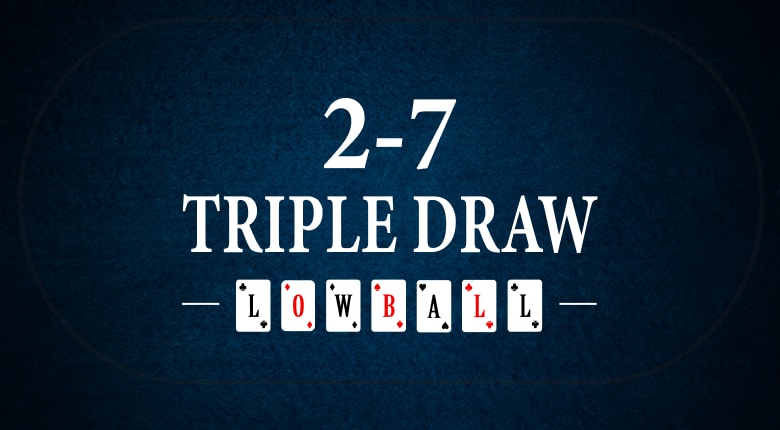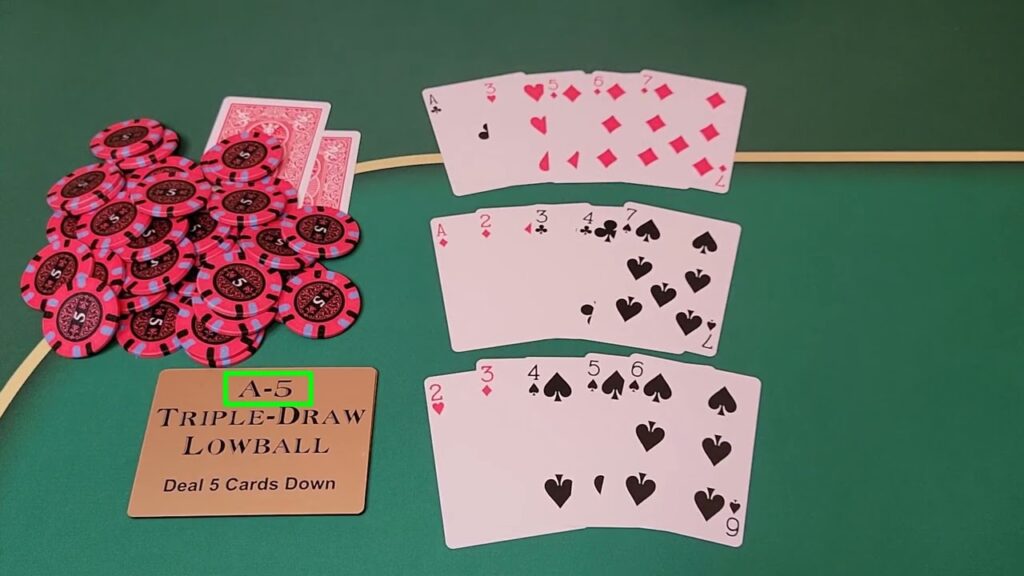Triple-draw lowball poker is a captivating game that combines skill, strategy, and mind games. At the core of poker’s appeal is the art of bluffing – a skill that can make or break a player’s success. In this blog post, we’re delving deep into the world of advanced bluffing techniques within the context of triple-draw lowball poker. We’ll break it down in a way that’s easy to understand, ensuring that even if you’re new to poker, you can quickly grasp these essential concepts.
Table of Contents
Introduction
Poker is popular for a reason – it’s a game where you can outsmart your opponents. Bluffing is a big part of that. It’s when you make others believe you have a stronger or weaker hand than you do. In triple-draw lowball poker, where the aim is to have the lowest hand, bluffing becomes crucial.
Why Bluffing Matters
In triple-draw lowball, you’re trying to create the lowest possible hand, like 2-3-4-5-7. Bluffing lets you pretend you have a strong low hand even when you don’t. This can make your opponents fold, securing the pot for you.
The Basics of Bluffing in Poker
What is Bluffing? Bluffing means making others believe your hand is different from what it is. It’s a vital part of poker strategy because it lets you win when your cards aren’t great.
Why Bluffing Matters in Triple Draw Lowball Here, bluffing is essential because it can help you win pots with weak hands. If you can trick your opponents into thinking you have a strong hand, they might fold and leave you the winner.
The Risks and Rewards Bluffing has its risks. If your bluff gets caught, you might lose your chips. But when you bluff successfully, the rewards can be huge. The key is to find the right moments and not overdo it.

Understanding Triple-Draw Lowball Poker
What Is Triple-Draw Lowball? It’s a poker variant where you aim to have the lowest hand by replacing and discarding cards over three rounds.
How It’s Different Triple-Draw Lowball differs from regular poker. Here, traditional poker hands like straights and flushes don’t count. Aces are always low, and that adds an extra layer of complexity.
Knowing Your Opponents Bluffing in triple-draw lowball means understanding your opponents. Are they cautious players who only bet with strong hands? Or are they quick to fold? Observing their style is key.
Advanced Bluffing Techniques
Picking the Right Moment Bluffing isn’t about doing it all the time. You must pick the right moments. When the community cards hint that your opponent missed their draw, that’s a good time.
Changing Your Image Your “table image” is how others see your playing style. If you’ve been playing conservatively, surprise them with some aggression. It can throw them off balance.
Betting Smart Your bet size can say a lot. A small bet may signal weakness, while a big one suggests strength. Understand how opponents interpret your bets.
The Bluff Math Calculate the “bluff equity” – the odds that your opponent will fold compared to the size of your bet. It helps you decide when to bluff.
Common Mistakes to Avoid in Triple-Draw Lowball

Triple draw lowball poker, a unique variant of the classic card game, presents both challenges and opportunities. To improve your game, it’s vital to recognize common mistakes and steer clear of them.
Mistake 1: Ignoring Hand Selection
One of the most frequent errors in triple-draw lowball is disregarding the importance of starting hand selection. In this game, the objective is to create the lowest possible five-card hand. Therefore, starting with a poor hand can put you at a significant disadvantage from the outset.
Solution: Prioritize hands with low cards and avoid high cards whenever possible. Hands like 2-3-4-5-7 or even better are excellent starting points. Discipline in hand selection is vital for long-term success.
Mistake 2: Overvaluing High Cards
Another prevalent mistake is overvaluing high cards, especially aces. While aces are the lowest cards in triple-draw lowball, having too many of them can hinder your chances of creating a strong low hand. Clinging to high cards in the hope of forming a pair or other traditional poker hands can lead to missed opportunities for low hands.
Solution: Focus on creating hands with no pairs, straights, or flushes. Embrace the low cards and understand that in this variant, aces are not your friends.
Mistake 3: Over-Betting or Under-Betting
Finding the right balance in betting can be challenging in triple-draw lowball. Some players tend to bet excessively, putting pressure on their opponents, while others bet too conservatively, missing opportunities to build the pot. Both extremes can be detrimental to your overall strategy.
Solution: Pay attention to the size of the pot and your opponent’s tendencies. Adjust your bets accordingly. Betting too much with a weak hand or too little with a strong hand can give away crucial information to your opponents.
Mistake 4: Not Managing Your Bankroll
Bankroll management is crucial in any form of poker, including triple-draw lowball. Players often make the mistake of not setting limits or managing their finances wisely, leading to significant losses.
Solution: Establish a clear bankroll management plan. Set limits on how much you’re willing to risk, and stick to them. Avoid chasing losses or playing at stakes that are beyond your comfort zone.
The Psychology of Bluffing
Reading Opponents Players often show subtle signs when they have strong or weak hands. Learn to read these tells to your advantage.
Consistency Matters If you act the same way whether you’re bluffing or not, it’s harder for opponents to figure you out.
Mind Games Sometimes, the best way to bluff is to make it seem like you’re not bluffing. Keep your opponents guessing.
Real-World Examples
We’ll share real hands where advanced bluffing strategies worked. You’ll see how players used timing, image, bet sizing, and psychology to win with their bluffs.
The Risks
Bluffing isn’t foolproof. Your opponents might catch on. We’ll discuss what to do if your bluffs fail and how to adapt when the game changes.
Conclusion
Bluffing in triple-draw lowball poker is an art you can master. Remember, practice is key. Whether you’re playing with friends or in a casino, try out these strategies. With time, you’ll become a better bluffer and a more formidable poker player.
Your Next Steps
- Learn More: If you’re hungry for more poker knowledge, there are plenty of resources out there. Books, articles, and videos can help you improve.
- Join the Conversation: Share your poker experiences, questions, or insights in the comments below. We’d love to hear from you and foster a vibrant poker community.
- Explore Further: If you want to delve deeper into poker strategy, check out these related resources:
- Link 1: Mastering Poker Mathematics
- Link 2: Reading Poker Tells: Unmasking Your Opponents
- Link 3: The Psychology of Poker: Mind Games at the Table
Remember, poker is as much about having fun as it is about winning. So, enjoy the game, and may your bluffs be legendary!
Frequently Asked Questions (FAQs)
Q1. What is the primary objective in this variant of poker?
A1. In this poker variant, the primary objective is to form the lowest possible five-card hand. Unlike traditional poker games, such as Texas Hold’em or Omaha, where you aim for high-ranking hands, here, the goal is to have the lowest hand to win.
Q2. Can I still win with a high hand?
A2. No, the rules of this variant do not reward high hands. Winning pots in this game requires having the lowest possible hand, so high hands like straights, flushes, and pairs are not advantageous.
Q3. How many drawing rounds are there in this game?
A3. There are typically three drawing rounds in this poker variant. After each drawing round, players have the opportunity to discard and draw new cards to improve their hand.
Q4. Are aces considered high or low in this game?
A4. In this variant, aces are always considered low cards. They hold the lowest possible value, making them valuable for creating low hands.
Q5. Is bluffing important in this poker game?
A5. Bluffing can be a valuable strategy in this game, just as it is in traditional poker variants. However, it’s essential to understand when and how to bluff effectively, given the unique low-hand objective.